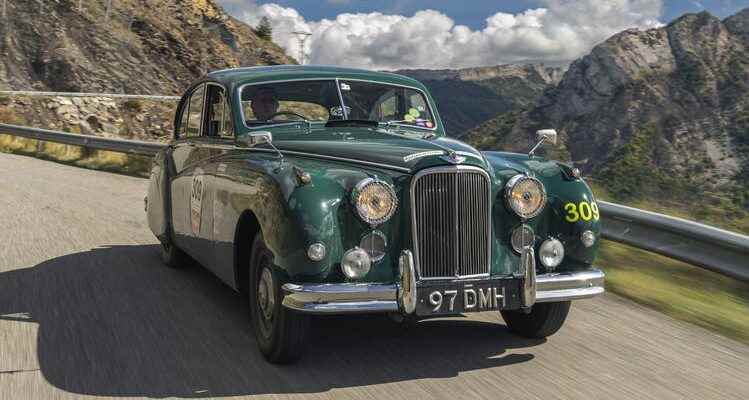The Jaguar Mark VII was not only once the fastest production luxury sedan, but could also do sports – it won the Rally Monte Carlo in 1956, among other things. Reason enough to hunt over the Alpine passes in such a specimen.
Even today, the Jaguar Mark VII M fits perfectly into the landscape of the Col de Turini.
“Hunting” over alpine mountains is one of those things when you’re out of fuel. Somewhere in the nowhere uphill the wonderful but underfed straight-six runs out. Heavy continuous rain paralyzed the windshield wipers even before departure, also poured through the ventilation into the fuel gauge and blinded the cover pane from the inside.
With slightly damp shins (yes, the wet also drips onto the lower extremities), we discuss what to do. On the many narrow, winding mountain passes, the car must have swallowed a good 18 liters per 100 kilometers. Fortunately, such a Jaguar has two tanks – we just have to find the button to switch. . .
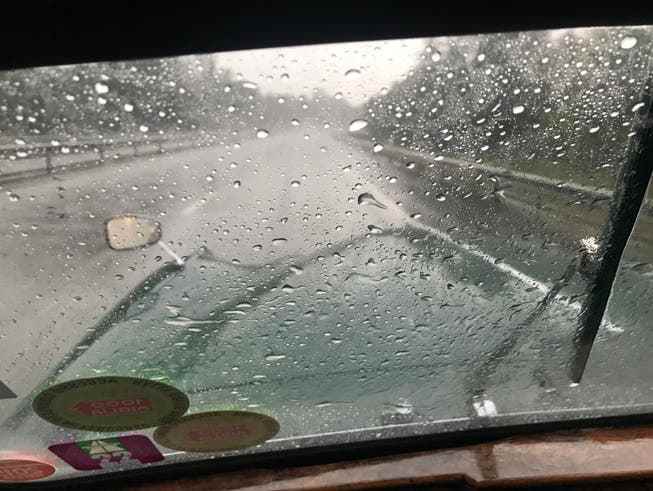
Without working windscreen wipers, the journey becomes an adventure.
One could lament the circumstances that the weather initially throws at us on the trail of some famous stages of the Monte Carlo Rally. But you can’t get in a bad mood with this car: We have the great pleasure of driving the Jaguar Mark VII M, the fastest luxury sedan of the 1950s. Which few people remember. Once advertised as a “sporty touring car with a high-performance engine” – the XK engine was actually made for this model by Jaguar founder and boss Sir William Lyons.
The now much more famous XK120 was launched two years earlier than the Mark VII in 1950. With initially 160 hp, the car was more than 160 km/h fast. For comparison: A similarly elegant Mercedes 300 came along with a meager 115 hp and was easily nibbled by such a Jaguar.
The British royal family was also interested
The car was based on the chassis of the predecessor, for the first time the fenders were integrated into the body. The side line that shows the relief of the XK120 is still successful today. Inside there is a lot of real wood and chrome-plated hard metal for ashtrays, cranks, hinged windows and door openers. The wheelbase is more than 3 meters, so there is plenty of legroom on the three-seater couch in the back. There is still enough space for the suitcases of all passengers – the car is almost 5 meters long and offered the largest trunk in this segment at the time.
Even then, the road holding and handling were considered excellent for such an affordable luxury car: when it appeared, it cost less than £1,000 before taxes. By the way: One of the customers was Queen Mom, who used the Mark VII as a private car for almost 20 years. Most copies were exported, mainly to America. In 1952, therefore, an optional automatic was installed in the car. Ultimately, the model ensured that Jaguar became a player in the market for large sporty luxury sedans: almost 31,000 examples of the Mk VII were built.
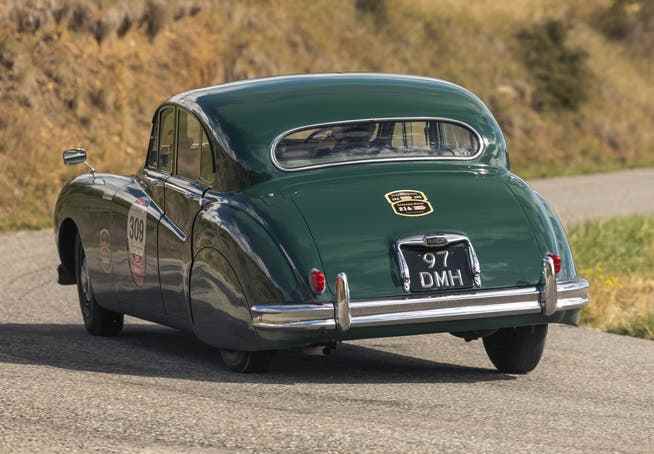
Comfort has its price. Nevertheless, the Mk VII still achieves high cornering speeds.
The car was also sporty. The Daily Express International Trophy, traditionally held at Silverstone, was considered one of the most important touring car races of the year at the time. Mark VII won the race four times in a row from 1952 to 1956: Winner in 1952 and 1953 was Stirling Moss, a year later Moss had to admit defeat to his teammate Ian Appleyard.
In 1955 Mike Hawthorn took the win, in 1956 Ivor Bueb won the race with the Jaguar Mark VII. In some cases (1954 and 1955) even all places on the podium went to drivers of the Jaguar Mark VII. A victory at the fast track in Northamptonshire, UK which the Mark VII could reach speeds of up to 190 km/h, excellently underlined the power and performance of the models.
Motorsport crowning glory
However, Jaguar managed the real highlight in 1956, when a Mark VII started at the Monte Carlo Rally – and won. Jaguar started with an M model (built from 1954). M stood for «Modified», which meant, among other things, fog lights, modified indicators, rear bumpers stretched as far as the wheel arches and larger taillights – but above all 30 hp more. With then 190 hp it was easy to race.
The 26th edition of the “Monte”, which was held for the first time in 1911, traditionally began as a rally with journeys of up to 3000 kilometers and the common meeting point in Paris. 309 starters made their way, the Jaguar Mk VII from Glasgow. 264 teams made it to the French capital without penalty points.
The further route to Monaco with some secret checkpoints then completed only 40 teams without penalty points. The large limousine from Coventry already offered the advantage here that passengers could stretch out in the spacious rear and take a little nap on the long journey to Monaco.
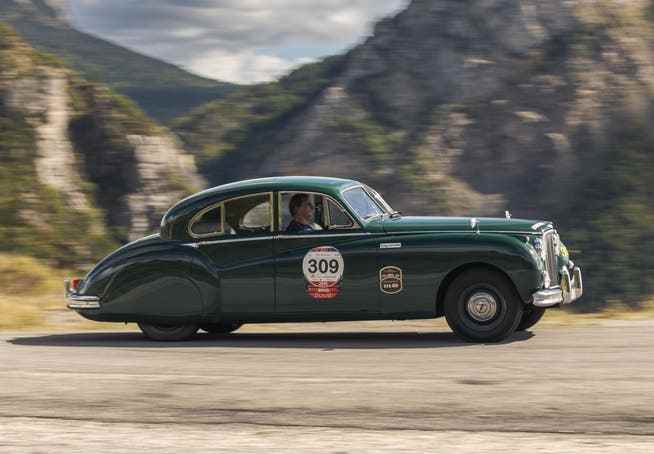
Just under 5 meters long and a long wheelbase: the limousine was also interesting for Queen Mom.
There was a pace and brake test running through the downhill hairpin bends between La Turbie and Monaco. Belfast’s Ronnie Adams and his co-drivers and mechanics Frank Biggar (Dublin) and Derek Johnston (Belfast) in the Jaguar Mk VII completed it in 42.3 seconds and took the lead, thanks in part to a specially ratioed gearbox that allowed the second gear up to 100 km/h. This brought advantages, especially on the uphill stretches such as the drive up to the notorious Col de Turini.
In 1956, the route also ran through the French Chartreuse Mountains between Chambéry and Grenoble for the first time, over passes up to 1326 meters high. The final loop through the Maritime Alps featured two passages over the Turini, and since the final test took place on the Grand Prix circuit, a one-kilometre stage with two hairpin turns ultimately decided victory.
After that, all the cars had to pass a “beauty test” – this checked whether the rear-view mirror, horn, headlights and bumper were intact and in perfect condition.
Start without wipers
We take over a right-hand drive Mark VII M at a rainy alpine hut in the pre-Alpine limestone massif Chartreuse. Okay, our windshield wipers aren’t intact – we just have to drive fast so that the drops roll off. For the freeway passages – the car can also do that – an electric overdrive is available, which lowers the speed as a “fifth gear”. But mostly cornering is the order of the day on the way from Geneva to Nice.
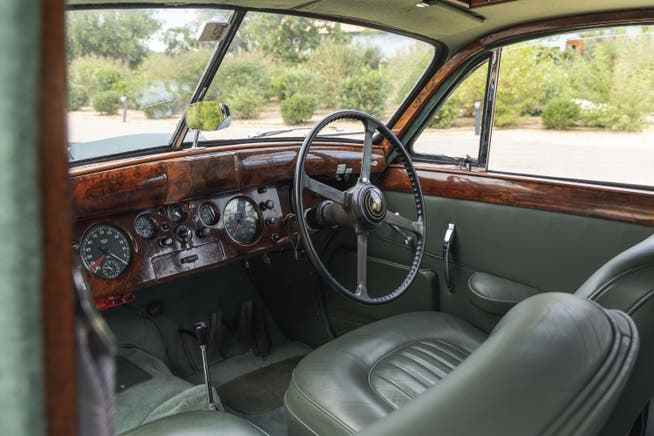
Comfortable seats, but hardly any lateral support: Sporty driving was only possible with a well-developed musculature of the pilot.
The first stage is the famous Jacob-Bellecombette-Le Sappey special stage (used in the Monte Carlo Rally from 1981 to 1987 and 1994). Later, on the ascent to the Col de la Croix, clouds still block views of the Massif des Écrins, for example. Then it goes over the original rally stage La Garde-Freinet to Saint-Auban, whereby the Furmeyer-Barcelonnette section was part of the Monte Carlo Rally 17 times and is therefore one of the most famous passages – apart from Sisteron-Thorad (28- drive in this competition).
The handling of the Mk VII M, which was equipped with larger anti-roll bars on the front axle (compared to the basic Mk VII), was already superior to many so-called “sports cars” at the time. Even the legendary Jaguar test driver Norman Dewis was full of praise: “Despite its weight and size, you could really throw it through the corners”, and top drivers such as Stirling Moss agreed with him.
Today we wonder how they did it back then. Almost like before the war, you sit in front of the huge steering wheel, which is close to the windscreen. The XK-like instruments are arranged in the middle, the passenger has the best view of the tachometer – with left-hand drive it would be the speedometer. The shift lever is quite short, but the shift travel is extremely long. The fully synchronized four-speed gearbox doesn’t like haste, but nice and slow searching and engaging the gears.
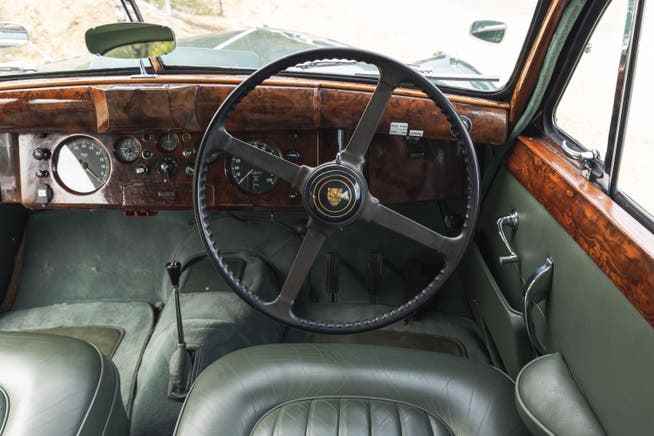
A large steering wheel and long shift travel demand everything from the driver.
The long wheelbase of more than 3 meters does not exactly make the car a super sports car. The turning circle is at least an acceptable 12.6 meters, but the biggest problem is the completely contourless seats. Even then, the occupants would slide around uncontrollably in fast corners. And so we get the idea that the main work of Adams’ co-drivers back then was probably to somehow fix him in the driver’s seat.
In addition, there is, well, “demanding” steering. There are four and a half turns from lock to lock, and as was usual at the time, very little happened in the first centimeters of steering left and right. The restoring forces, on the other hand, are enormous, and you need two pretty strong arms to steer the 1.7-tonne car, which weighs a good 1.7 tons and has very soft suspension, as precisely as possible through bends and serpentines.
Fortunately, you can rely on the four drum brakes – they are “vacuum-assisted”, as an advertisement from back then promises. However, the DOHC engine is unbeatable – low-vibration and smooth-running and blessed with a torque that allows you to start off in second gear and lazily shift gears. Incidentally, the almost 1.7-tonne car hardly oversteers. Since before the tires beg whining for mercy.
At the end of the journey, we think that the words “mountain pass” and “mountain pass” differ only in an “s”, reminiscent of serpentines. Even in a Jaguar Mark VII M. . .
